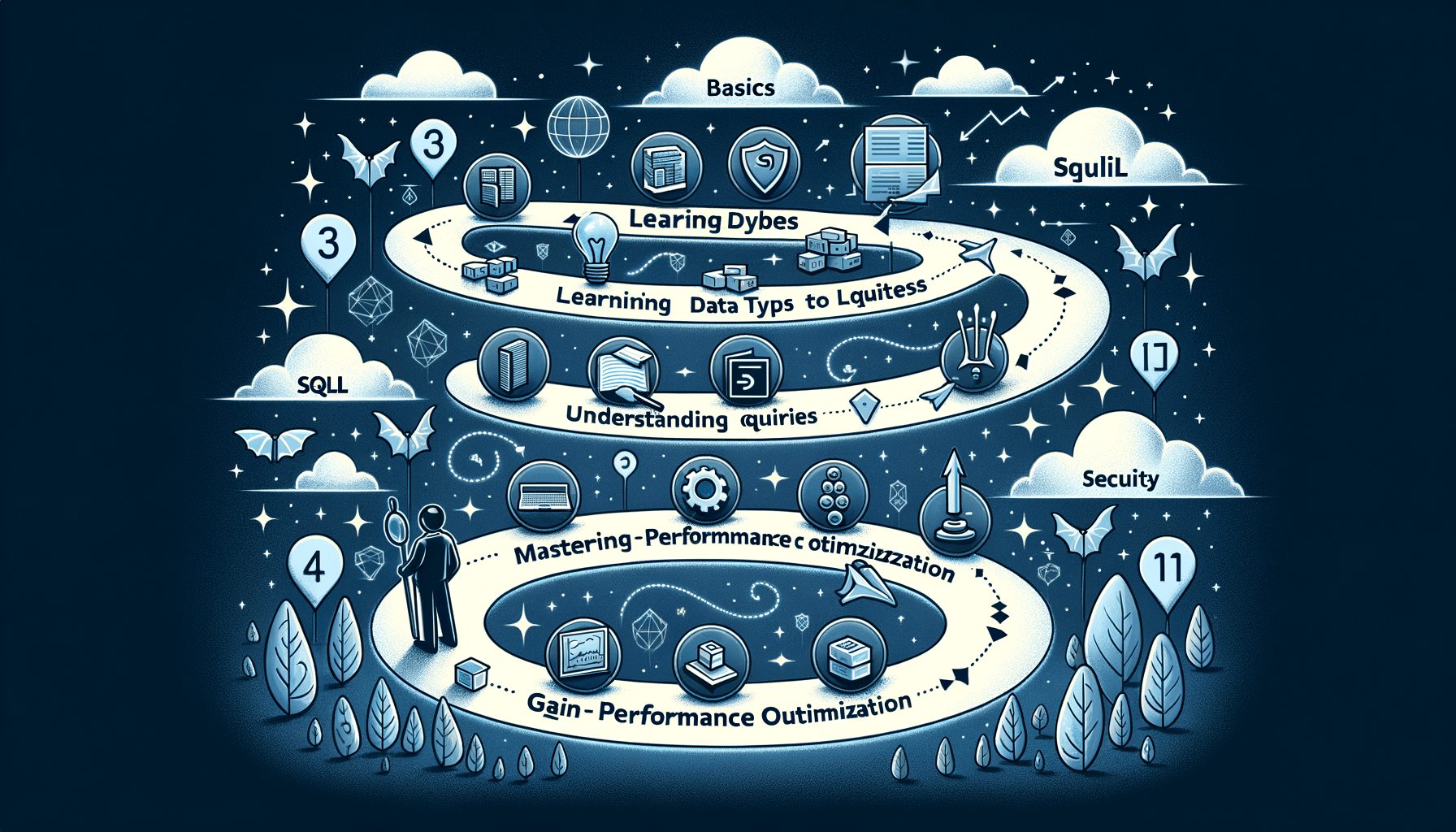A big variety of articles and resources

Mastering SQL Programming Language: A Comprehensive Guide for Beginners
 Sia Author and Instructor
Learn SQL
Sia Author and Instructor
Learn SQL
13 minute read
Learning SQL is essential for anyone looking to work with databases. This guide will walk you through the basics and advanced features of SQL, helping you to become proficient in this powerful programming language.
Key Takeaways
- Understand the core components and importance of SQL.
- Learn how to set up and configure your SQL environment.
- Master fundamental SQL commands and syntax.
- Explore advanced query techniques and performance optimization.
- Discover real-world applications of SQL in various industries.
Understanding the Basics of SQL Programming Language
Defining SQL and Its Importance
SQL, or Structured Query Language, is a standard language used to communicate with databases. It allows you to create, read, update, and delete data. Understanding SQL is crucial because it is the backbone of database management and is widely used in various industries.
Historical Context and Evolution
SQL was developed in the 1970s by IBM researchers. Over the years, it has evolved to become the standard language for relational database management systems (RDBMS). Its importance has grown as data has become a critical asset for businesses.
Core Components of SQL
SQL consists of several key components:
- Data Definition Language (DDL): Used to define and manage database structures.
- Data Manipulation Language (DML): Allows you to insert, update, delete, and retrieve data.
- Data Control Language (DCL): Manages access to the data.
- Transaction Control Language (TCL): Handles transactions within the database.
Mastering these components is essential for anyone looking to become proficient in SQL.
Setting Up Your SQL Environment
Choosing the Right SQL Database
When starting with SQL, selecting the right database is crucial. Popular options include MySQL, PostgreSQL, and SQLite. Each has its own strengths and weaknesses, so consider your project needs carefully. MySQL is widely used for web applications, while PostgreSQL is known for its advanced features. SQLite is lightweight and perfect for small projects or learning purposes.
Installing SQL Tools and Software
Once you've chosen your database, the next step is to install the necessary tools and software. Most databases offer easy-to-follow installation guides on their official websites. For instance, MySQL provides a comprehensive installer that includes all required components. Make sure to download the latest version to avoid compatibility issues.
Configuring Your Development Environment
After installation, configuring your development environment is essential for a smooth workflow. This involves setting up your database, creating user accounts, and assigning permissions. Additionally, you might want to install a graphical user interface (GUI) tool like phpMyAdmin for MySQL or pgAdmin for PostgreSQL to simplify database management.
Proper setup of your SQL environment lays the foundation for effective data management and manipulation.
By following these steps, you'll be well on your way to mastering SQL and handling data efficiently.
Fundamental SQL Commands and Syntax
SELECT Statements
The SELECT statement is the cornerstone of SQL. It allows you to retrieve data from one or more tables. Understanding how to use SELECT effectively is crucial for any SQL programmer. Here's a basic example:
SELECT column1, column2 FROM table_name;
INSERT, UPDATE, and DELETE Commands
These commands are essential for modifying data in your database:
- INSERT: Adds new rows to a table.
- UPDATE: Modifies existing data in a table.
- DELETE: Removes rows from a table.
Example of an INSERT statement:
INSERT INTO table_name (column1, column2) VALUES (value1, value2);
Basic SQL Functions
SQL functions perform operations on data. Some common functions include:
- COUNT(): Counts the number of rows.
- SUM(): Adds up values.
- AVG(): Calculates the average value.
Here's how you might use the COUNT() function:
SELECT COUNT(*) FROM table_name;
Mastering these fundamental commands and functions will set a strong foundation for more advanced SQL techniques.
Working with SQL Joins
INNER JOIN Explained
When you need to combine rows from two or more tables based on a related column, you use an INNER JOIN. This type of join returns only the rows where there is a match in both tables. It's essential for ensuring data consistency across your database.
LEFT JOIN and RIGHT JOIN
LEFT JOIN returns all rows from the left table and the matched rows from the right table. If there is no match, the result is NULL from the right side. RIGHT JOIN works similarly but returns all rows from the right table and the matched rows from the left table. These joins are useful for data completeness.
Practical Examples of SQL Joins
To master SQL joins, practice is key. Here are some examples:
- INNER JOIN: SELECT employees.name, departments.name FROM employees INNER JOIN departments ON employees.dept_id = departments.id;
- LEFT JOIN: SELECT employees.name, departments.name FROM employees LEFT JOIN departments ON employees.dept_id = departments.id;
- RIGHT JOIN: SELECT employees.name, departments.name FROM employees RIGHT JOIN departments ON employees.dept_id = departments.id;
Practicing these examples will help you understand how joins work and how they can be used to retrieve related data from multiple tables.
Advanced SQL Query Techniques
Subqueries and Nested Queries
Subqueries, also known as inner queries, are queries within another SQL query. They are useful for breaking down complex problems into simpler parts. For example, you can use a subquery to find the average salary in a department and then use that result in a main query to find employees earning above that average.
Using UNION and UNION ALL
The UNION operator is used to combine the results of two or more SELECT statements. Each SELECT statement within the UNION must have the same number of columns in the result sets with similar data types. The UNION ALL operator is similar but includes duplicate rows. Understanding the difference between UNION and UNION ALL is crucial for efficient data retrieval.
Optimizing Query Performance
Optimizing SQL queries is essential for improving the performance of your database. Techniques include indexing, query rewriting, and analyzing query execution plans. Indexing, for instance, can significantly speed up data retrieval by reducing the amount of data scanned. Efficient queries not only save time but also reduce the load on the database server.
Mastering these advanced techniques will make you proficient in handling complex data retrieval tasks, ensuring your SQL skills are robust and versatile.
Managing Database Schemas
Creating and Modifying Tables
When working with SQL, one of the first tasks you'll encounter is creating and modifying tables. Tables are the backbone of any database, storing all the data in a structured format. To create a table, you use the CREATE TABLE statement, specifying the table name and columns. Modifying tables can be done using the ALTER TABLE statement, which allows you to add, delete, or modify columns.
Understanding Primary and Foreign Keys
Primary and foreign keys are essential for maintaining relationships between tables. A primary key is a unique identifier for each record in a table, ensuring that no two rows have the same key. A foreign key links one table to another, establishing a relationship between the two. This is crucial for maintaining data integrity and enabling complex queries.
Schema Design Best Practices
Designing a database schema requires careful planning. Here are some best practices:
- Normalize your data: Ensure that your data is organized efficiently to reduce redundancy.
- Use meaningful names: Table and column names should be descriptive and easy to understand.
- Plan for scalability: Design your schema to handle future growth and changes.
- Document your schema: Keep a record of your schema design and any changes made over time.
A well-designed schema not only improves performance but also makes it easier to manage and understand your database.
Ensuring Data Integrity and Security
Implementing Constraints
To maintain the accuracy and consistency of your data, it's essential to implement constraints. Constraints are rules applied to database columns to ensure valid data entry. Common types include:
- Primary Key: Ensures each record is unique.
- Foreign Key: Maintains referential integrity between tables.
- Unique: Guarantees all values in a column are different.
- Check: Validates data against a condition.
Data Validation Techniques
Data validation is crucial for maintaining trust in data. It involves verifying the accuracy and quality of data before it is processed. Techniques include:
- Input Validation: Ensures data entered meets specific criteria.
- Format Validation: Checks if data follows a predefined format.
- Range Validation: Confirms data falls within a specified range.
SQL Injection Prevention
SQL injection is a common attack where malicious SQL code is inserted into a query. To protect your database, follow these best practices:
- Use Prepared Statements: They separate SQL logic from data input.
- Validate User Input: Always check and sanitize inputs.
- Limit Database Permissions: Grant only necessary permissions to users.
Ensuring data integrity is crucial for maintaining trust in data. Database security involves protecting data from unauthorized access through best practices like strong passwords, role-based access control, and encryption.
By implementing these strategies, you can significantly enhance the security and reliability of your SQL databases.
SQL for Data Analysis
Aggregating Data with GROUP BY
When working with large datasets, the GROUP BY clause is essential. It allows you to group rows that have the same values in specified columns into summary rows. For example, you can group sales data by region to see total sales per area. Mastering SQL enhances data analysis and reporting capabilities, enabling analysts to perform complex queries and uncover valuable insights.
Filtering Data with HAVING
The HAVING clause is used to filter groups based on a condition. Unlike the WHERE clause, which filters rows before grouping, HAVING filters after the grouping is done. This is particularly useful for conditions on aggregated data, such as finding regions with sales greater than a certain amount.
Advanced Analytical Functions
SQL offers a variety of advanced functions for data analysis. Functions like RANK(), DENSE_RANK(), and ROW_NUMBER() help in ranking and numbering rows within partitions. These functions are crucial for tasks like identifying top-performing products or employees within different departments.
Integrating SQL with data visualization tools simplifies data collection and reporting, making analysts vital in data-driven decisions.
Performance Tuning and Optimization
Indexing Strategies
Indexing is crucial for speeding up data retrieval. Proper indexing can drastically reduce the time it takes to execute queries. There are different types of indexes, such as single-column and composite indexes. It's important to choose the right type based on your query patterns.
Query Execution Plans
Understanding query execution plans helps you see how SQL Server processes your queries. By analyzing these plans, you can identify bottlenecks and optimize your queries for better performance. Use tools like EXPLAIN in MySQL or EXPLAIN PLAN in Oracle to get detailed insights.
Database Maintenance Tips
Regular maintenance tasks like updating statistics, rebuilding indexes, and cleaning up unused data can keep your database running smoothly. Here are some key tasks:
- Update Statistics: Ensures the query optimizer has the latest information.
- Rebuild Indexes: Helps in defragmenting indexes for faster access.
- Clean Up Data: Removes obsolete data to free up space and improve performance.
Consistent maintenance is essential for optimal database performance. Neglecting these tasks can lead to slow query responses and system inefficiencies.
Real-World Applications of SQL
Case Studies in Various Industries
SQL is used in many industries to manage and analyze data. For example, in healthcare, SQL helps in managing patient records and medical histories. In finance, it is used to track transactions and manage accounts. Retailers use SQL to manage inventory and sales data.
SQL in Business Intelligence
Business Intelligence (BI) relies heavily on SQL for data analysis and reporting. SQL queries help in extracting meaningful insights from large datasets, which can drive strategic decisions. BI tools often integrate with SQL databases to provide real-time analytics.
Future Trends in SQL Development
The future of SQL includes advancements in cloud computing and big data. As data grows, SQL is evolving to handle larger datasets more efficiently. Machine learning and AI are also being integrated with SQL to provide more advanced data analysis capabilities.
SQL is not just a tool for database administrators; it is a versatile language that can be applied in various real-world scenarios to solve complex problems.
Resources for Continued Learning
Recommended Books and Courses
To truly master SQL, it's essential to keep learning. Books like "SQL for Dummies" and "Learning SQL" are great for beginners. For more advanced learners, "SQL Performance Explained" is a must-read. Online courses from platforms like Codecademy and Khan Academy offer interactive lessons that can help you grasp both basic and advanced SQL concepts effectively.
Online Communities and Forums
Joining online communities can be incredibly beneficial. Websites like Stack Overflow and Reddit have active SQL communities where you can ask questions and share knowledge. Participating in these forums can help you solve problems faster and learn from others' experiences.
Certifications and Career Paths
Earning a certification can significantly boost your career prospects. Certifications like Microsoft Certified: Azure Database Administrator Associate and Oracle Certified Professional can make you stand out in the job market. These certifications not only validate your skills but also open up numerous opportunities in various fields, from data analysis to web development and business intelligence.
The journey to mastering SQL is a gradual process, but with dedication and the right resources, anyone can achieve proficiency.
Keep growing your skills with our resources! Whether you're just starting or looking to advance, we have something for everyone. Visit our website to explore a variety of courses and materials designed to help you succeed. Don't miss out on the chance to boost your knowledge and career!
Conclusion
Mastering SQL is a valuable skill that opens doors to many career opportunities. This guide has covered the basics and some advanced topics to give you a strong foundation. Remember, practice is key to becoming proficient. Keep experimenting with different queries and databases. As you continue to learn and grow, you'll find that SQL becomes an indispensable tool in your data management toolkit. Happy querying!
Frequently Asked Questions
What is SQL?
SQL stands for Structured Query Language. It's used to manage and manipulate databases.
Why should I learn SQL?
SQL is essential for managing data in various fields like business, healthcare, and technology. It helps you query and update databases.
Is SQL hard to learn?
No, SQL is considered one of the easier programming languages to learn. With practice, you can master the basics quickly.
What tools do I need to start learning SQL?
You will need a computer, an internet connection, and SQL software like MySQL or PostgreSQL to practice on.
Can I use SQL on any database?
Yes, SQL can be used on many types of databases like MySQL, PostgreSQL, and Oracle. The basic commands are similar across different systems.
How long does it take to learn SQL?
The basics of SQL can be learned in a few weeks. However, mastering advanced concepts may take a few months.
What are some common SQL commands?
Common SQL commands include SELECT, INSERT, UPDATE, and DELETE. These commands help you retrieve and modify data in a database.
Are there online resources to learn SQL?
Yes, there are many online courses, tutorials, and forums where you can learn SQL. Websites like Codecademy and Coursera offer SQL courses.
Related Articles

Mastering Data: Learn SQL from Basics to Advanced
14 minute read

Mastering Data: Learn SQL from Basics to Advanced
14 minute read





